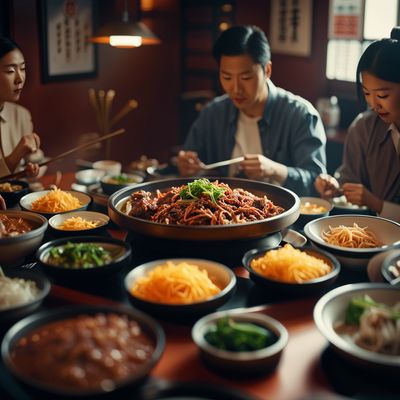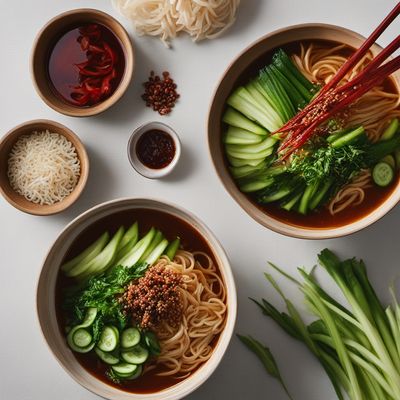
Recipe
Grilled Seaweed Rolls with Sesame Sauce
Savory Seaweed Delight: Grilled Gim Gui with Irresistible Sesame Sauce
4.8 out of 5
Indulge in the flavors of Korean cuisine with this delectable recipe for Grilled Seaweed Rolls with Sesame Sauce. This dish showcases the essence of Korean cuisine, combining the umami-rich seaweed with a flavorful sesame sauce.
Metadata
Preparation time
20 minutes
Cooking time
6-8 minutes
Total time
30 minutes
Yields
4 servings
Preparation difficulty
Medium
Suitable for
Vegetarian, Vegan, Gluten-free, Dairy-free, Nut-free
Allergens
Soy, Sesame
Not suitable for
Paleo, Keto, Low-carb, High-protein, Low-fat
Ingredients
-
10 sheets of gim (dried seaweed) 10 sheets of gim (dried seaweed)
-
2 cups (400g) cooked rice 2 cups (400g) cooked rice
-
1 cup (150g) julienned vegetables (carrots, cucumbers, bell peppers, etc.) 1 cup (150g) julienned vegetables (carrots, cucumbers, bell peppers, etc.)
-
1 cup (200g) cooked protein (tofu, chicken, beef, or shrimp) 1 cup (200g) cooked protein (tofu, chicken, beef, or shrimp)
-
2 tablespoons sesame oil 2 tablespoons sesame oil
-
2 tablespoons soy sauce 2 tablespoons soy sauce
-
1 tablespoon honey or maple syrup 1 tablespoon honey or maple syrup
-
1 tablespoon toasted sesame seeds 1 tablespoon toasted sesame seeds
-
2 cloves garlic, minced 2 cloves garlic, minced
-
Salt, to taste Salt, to taste
Nutrition
- Calories (kcal / KJ): 250 kcal / 1046 KJ
- Fat (total, saturated): 6g, 1g
- Carbohydrates (total, sugars): 42g, 4g
- Protein: 8g
- Fiber: 3g
- Salt: 1g
Preparation
-
1.Preheat the grill to medium heat.
-
2.In a bowl, combine the cooked rice, julienned vegetables, cooked protein, sesame oil, soy sauce, honey or maple syrup, toasted sesame seeds, minced garlic, and a pinch of salt. Mix well to combine.
-
3.Lay a sheet of gim on a clean surface and place a spoonful of the rice mixture on one end of the seaweed.
-
4.Roll the seaweed tightly, tucking in the filling as you go.
-
5.Repeat the process with the remaining gim and filling.
-
6.Place the seaweed rolls on the preheated grill and cook for 2-3 minutes on each side, or until the seaweed is slightly crispy and the filling is heated through.
-
7.Remove the rolls from the grill and let them cool for a few minutes.
-
8.Cut the rolls into bite-sized pieces and serve with the sesame sauce.
Treat your ingredients with care...
- Gim (dried seaweed) — Make sure to handle the gim gently to avoid tearing. If the gim is too brittle, you can lightly dampen it with water to make it more pliable for rolling.
Tips & Tricks
- To add extra flavor to the filling, you can marinate the protein (tofu, chicken, beef, or shrimp) in soy sauce and garlic before cooking.
- If you prefer a spicier version, you can add a dash of gochujang (Korean chili paste) to the filling mixture.
- Serve the grilled seaweed rolls with a side of kimchi for a traditional Korean touch.
- If you don't have a grill, you can pan-fry the seaweed rolls in a lightly oiled skillet over medium heat.
- Leftover seaweed rolls can be stored in the refrigerator for up to 2 days. Reheat them in a toaster oven or microwave before serving.
Serving advice
Serve the Grilled Seaweed Rolls with Sesame Sauce as an appetizer or a light meal. Arrange the bite-sized rolls on a platter and drizzle the sesame sauce over them. Garnish with additional toasted sesame seeds and chopped green onions for a pop of color.
Presentation advice
For an elegant presentation, arrange the grilled seaweed rolls in a circular pattern on a rectangular plate. Place a small bowl of sesame sauce in the center of the plate and sprinkle some toasted sesame seeds and finely chopped fresh herbs over the rolls.
More recipes...
More Korean cuisine dishes » Browse all

Bulgogi
Bulgogi is a Korean dish that is made with marinated beef that is grilled or stir-fried. It is a popular dish in Korea and is enjoyed by many...

Pa kimchi
Pa kimchi is a traditional Korean side dish made with scallions and napa cabbage. It is a spicy and sour dish that is often served with rice and...

Sannakji
Live Octopus
Sannakji is a traditional Korean dish that consists of live octopus that is cut into small pieces and served raw. It is a unique and adventurous...






